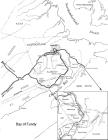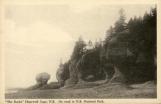1
Introduction to Albert CountyAlbert County is located in the southern part of New Brunswick along the Bay of Fundy, the body of water which separates the Provinces of New Brunswick and Nova Scotia.
2
This map shows South Eastern New Brunswick, Canada including Albert County.15 September 2003
Albert County, New Brunswick, Canada

3
New Brunswick is known as the Picture Province, and certainly Albert County is a good example of why New Brunswick has earned this title.... From the hills of Fundy National Park where large lumbering operations took place, to the small fishing village of Alma where tall ships were built.... Up the coast along the highway to Albert where the first Acadian settlements were built.... Through Hopewell Cape where thousands of visitors come each year to see the World Famous Hopewell Rocks, which are carved from the banks of the river by the force of the highest tides in the world.4
The World Famous Flower Pot Rocks in Hopewell Cape.15 September 1910
Hopewell Cape, New Brunswick, Canada

5
Continuing along the Petitcodiac river past Hillsborough and onto Riverview located across the river from the economic center of southern New Brunswick, the City of Moncton. At Moncton visitors watch the surging tidal waters form a wave of water, known as the tidal bore, as it travels up the river. This tidal bore you will learn was quite a danger to the lives of residents in this part of the county in the past. Finally back into the hills and valleys around Elgin where later settlers established farms and built a community. Albert County is indeed a beautiful place but as you read this presentation you will learn more about the struggles of the people who arrived here from distant lands and began to build homes and businesses. The roots they established are still found in the local communities today.The geography of Albert County has two striking features, the first being the Bay of Fundy and the second being the hills, which are part of the Appalachian Highland Mountain Range, that run along the coastline of the Bay and form the majority of the land mass in the County. Both of these geographic features were formed over a million years ago when the movement of ice during the ice age carved out the Bay and deposited soil on the mountains. This mixture of hills covered with valuable timber and containing deposits of precious minerals, so close to the rivers running into the Bay would help to create a strong industrial base in the county during the 1800's.
The first people to live in the area were the Native people known as the Micmac. They lived off the land hunting game in the hills and fishing from the rivers and the Bay. The first European to arrive was Samuel de Champlain in 1604, he claimed all of Albert County for the King of France. Settlement by the French began in 1698. Life was hard for those first settlers but their communities continued to grow until the Expulsion of the Acadians in 1755. Soon other European settlers would arrive and establish new communities. It was during the late 1700's, with the arrival of tens of thousands of Loyalist refugees from the American Revolutionary War that pressure began to build to separate New Brunswick and Nova Scotia into two Provinces. Originally following the split of the two provinces in 1784, Albert County was part of Westmorland County. However, with the economic and population growth of the county in the early 1800's pressure began to build to create a separate county. So in 1845, the county of Albert was established and named in honour of the Prince Consort. The economy of Albert County boomed in the nineteenth century during the age of sail, but as with other lumbering and shipbuilding based economies of the day, during the early twentieth century the economy began to stall. Following the slow down in the local economy many of the immigrants who had arrived here during the economic boom of the nineteenth century decided to pack up and move once again in search of a better life elsewhere. Many of the people who left Albert County went on to help start new settlements in Western Canada and the United States. Today some of the descendants of those people return to Albert County from places all over the world to trace the genealogy of their families. Today the population in most communities of Albert County is much smaller than in the nineteenth century. The economy is based mostly on tourism - little wonder with the number one and number three tourist attractions in the province being located in the County. This presentation focuses on the history of the county from the 1700's when the first Acadians arrived until the late 1800's when the industries of the County boomed. We hope that you enjoy this presentation - should you have any questions, comments, or corrections please contact us at albertcountymuseum@nb.aibn.com